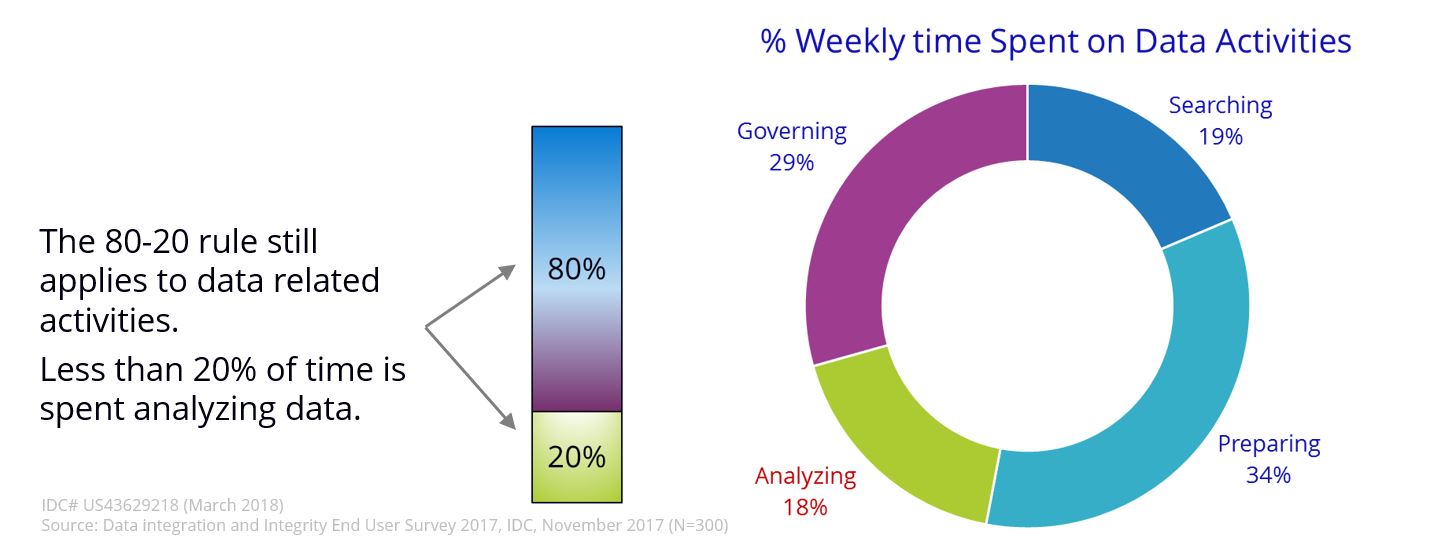The proliferation of data types and quantities should be a major advantage for enterprise organizations. More data and more types of data should offer complex insights into challenges and opportunities in how the business runs and should lead to better decisions and business outcomes. However, ask any data analyst, and they’ll share this reality: data analysts spend a bulk of their time on search, data preparation, management, and governance activities, and not on data analytics where the true value lies.
The 80/20 Rule is Alive and Well in Data Management
In fact, the breakdown of time spent on data preparation versus data analytics is woefully lopsided; less than 20% of time is spent analyzing data, while 82% of the time is spent collectively on searching for, preparing, and governing the appropriate data.

Why the Data Management Time Crunch is Only Getting Worse
The number of data types that need to be collected and analyzed is on the rise. In a recent IDC survey, 80% of respondents indicated that in the next 24 months, there will be a significant increase in the number of different types of data that need to be analyzed. Different types of data will require additional data search and collection processes, which adds to the overall time spent on data management, leaving less time for meaningful analysis.
The data that needs to be analyzed is also becoming increasingly complex, adding to the time needed for overall data management. In fact, IDC predicts that the amount of data volumes worldwide will increase by 10x by 2025. Both of these factors compound the amount of time spent outside of data analytics, where the value for the organization is actually gained. Additionally, new industry regulations about data collection and use, such as the recent General Data Privacy Regulation (GDPR) will also increase the amount of time spent in data preparation.
How to Reduce Data Management Lead Times and Make Room for Analytics
Organizations that want to empower their data analysts to spend more time deriving meaningful insights from their data will need to look for opportunities to use Third Platform technology to reduce data management lead times. Machine learning has the potential to significantly change the way data is managed and automate many of the tasks related to data. Some examples include machine-generated recommendations for:
- which federation to use
- which data visualizations are best for the current circumstance
- which algorithm to use for the specific use-case.
To successfully incorporate machine learning into data management, enterprises will need to track data consumption and utilization. They should apply analytics to determine which repetitive data management tasks should be automated.
The growth in data intelligence software is uncovering new insights into data consumption and utilization, and cognitive data analytics solutions can learn from these insights and eliminate/automate repetitive tasks from the decision-making process.
The 80/20 rule for data management versus analytics is a sad reality for most organizations, but it doesn’t have to be a permanent state. By identifying and automating the most time-consuming, repetitive tasks, enterprise organizations can free their data analysts up to complete more meaningful data analysis – and derive better value from their data for the entire business.
Want to learn more about the value hiding in your data capital? Watch IDC’s on-demand webinar, “Unlock the Power of Data Capital to Accelerate Digital Transformation”, to learn more about the role data plays in an organization, and how and an emphasis on utilizing data capital will drive success for organizations.




